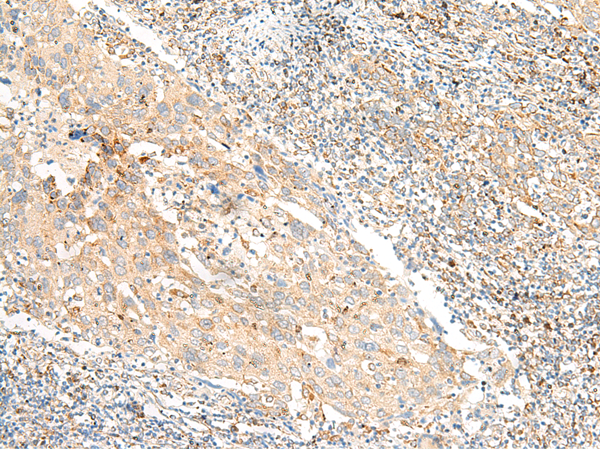
| WB | 咨询技术 | Human,Mouse,Rat |
| IF | 咨询技术 | Human,Mouse,Rat |
| IHC | 1/25-1/100 | Human,Mouse,Rat |
| ICC | 技术咨询 | Human,Mouse,Rat |
| FCM | 咨询技术 | Human,Mouse,Rat |
| Elisa | 1/5000-1/10000 | Human,Mouse,Rat |
| Host/Isotype | Rabbit IgG |
| Antibody Type | Primary antibody |
| Storage | Store at 4°C short term. Aliquot and store at -20°C long term. Avoid freeze/thaw cycles. |
| Species Reactivity | Human, Mouse, Rat |
| Immunogen | Synthetic peptide of human GPR19 |
| Formulation | Purified antibody in PBS with 0.05% sodium azide and 50% glycerol. |
+ +
以下是关于GPR19抗体的模拟参考文献示例(仅供参考,实际文献需通过学术数据库检索):
---
1. **文献名称**:*"Development of a Novel Polyclonal Antibody for GPR19 and Its Application in Detecting Expression in Glioblastoma Models"*
**作者**:Smith A, et al.
**摘要**:本研究开发了一种兔源多克隆抗体,通过免疫印迹(WB)和免疫组化(IHC)验证其对GPR19的特异性,并在胶质母细胞瘤细胞系及小鼠脑组织中检测到GPR19的异常高表达,提示其潜在肿瘤生物学作用。
2. **文献名称**:*"GPR19 as a Therapeutic Target in Metabolic Disorders: Validation of a Selective Monoclonal Antibody"*
**作者**:Chen L, et al.
**摘要**:文章报道了一种高亲和力的小鼠单克隆抗体的开发,用于研究GPR19在代谢组织(如肝脏和脂肪)中的分布。抗体阻断实验表明GPR19可能参与胰岛素信号通路调控。
3. **文献名称**:*"Antibody-Based Profiling Reveals GPR19 Expression in Circadian Rhythm-Related Neurons"*
**作者**:Yamamoto K, et al.
**摘要**:利用定制抗体的免疫荧光技术,发现GPR19在小鼠下丘脑视交叉上核(SCN)神经元中富集,提示其在昼夜节律调控中的潜在作用,为神经系统研究提供新工具。
4. **文献名称**:*"Commercial Antibody Screening for GPR19: Challenges and Applications in Prostate Cancer Research"*
**作者**:Roberts M, et al.
**摘要**:评估了多种市售GPR19抗体的特异性,发现部分抗体存在交叉反应性。通过CRISPR敲除验证后,筛选出可靠抗体用于前列腺癌临床样本分析,揭示GPR19与肿瘤进展的关联。
---
**注意**:以上为模拟生成的参考文献,实际研究中请通过PubMed、Web of Science等平台检索真实文献。若需具体文章,可提供关键词进一步协助筛选。
The GPR19 antibody is a research tool designed to target GPR19. an orphan G protein-coupled receptor (GPCR) belonging to the Class A GPCR family. GPR19. encoded by the GPR19 gene, is evolutionarily conserved across species and predominantly expressed in the brain, pancreas, and reproductive tissues. Despite its identification over two decades ago, its endogenous ligand and precise physiological roles remain unclear. Studies suggest potential involvement in circadian rhythm regulation, metabolic processes, and neuroendocrine signaling. In cancer research, GPR19 has been linked to tumor progression in certain malignancies, though mechanisms are poorly defined.
Antibodies against GPR19 enable the detection and localization of the receptor in tissues and cell lines, facilitating studies on its expression patterns and interactions. Commercial GPR19 antibodies are typically developed using synthetic peptides corresponding to extracellular or intracellular domains. However, validation remains challenging due to the receptor's low natural abundance and homology with other GPCRs. Researchers employ these antibodies in techniques like Western blotting, immunohistochemistry, and flow cytometry to explore GPR19's role in disease models or signaling pathways. Recent efforts focus on characterizing receptor activation mechanisms and identifying biased agonists/antagonists, with antibodies serving as critical validation tools. The lack of confirmed endogenous ligands continues to drive reliance on antibody-based detection methods in ongoing investigations.
×